Cyborgs

“Claude Elwood Shannon is considered as the founding father of [the] electronic communications age,” writes New York University. “While working at Bell Laboratories, he formulated a theory explaining the communication of information and worked on the problem of most efficiently transmitting information”:
Shannon joined Bell Telephone Laboratories as a research mathematician in 1941. He worked on the problem of most efficiently transmitting information. Soon he discovered the similarity between boolean algebra and telephone switching circuits. By 1948, Shannon turned his efforts toward a fundamental understanding of the problem and had evolved a method of expressing information in quantitative form. The fundamental unit of information is a yes-no situation.i Either something is or is not. This can be easily expressed in Boolean two-value binary algebra by 1 and 0, so that 1 means “on” when the switch is closed and the power is on, and 0 means “off” when the switch is open and power is off. Under these circumstances, 1 and 0 are binary digits, a phrase that can be shortened to “bits.” Thus the unit of information is the bit. A more complicated information can be viewed as built up out of combinations of bits. For example, the game of “twenty questions,” shows how quite complicated objects can be identified in twenty bits or less, using the rules of the game. Also, something much more elaborate, such as is seen by the human eye, can also be measured in bits. Since each cell of the retina might be viewed as recording “light” or “dark” (“yes” or “no”) and it is the combination of these yes-no situations that makes up the complete
picture.1
“In a landmark paper written at Bell Labs in 1948, Shannon defined in mathematical terms what information is and how it can be transmitted in the face of noise,” notes Scientific American:
Shannon defined the quantity of information produced by a source – for example, the quantity in a message – by a formula similar to the equation that defines thermodynamic entropy in physics. In its most basic terms, Shannon’s informational entropy is the number of binary digits required to encode a message. Today that sounds like a simple, even obvious way to define how much information is in a message.…
As well as defining information, Shannon analyzed the ability to send information through a communications channel. He found that a channel had a certain maximum transmission rate that could not be exceeded. Today we call that the bandwidth of the channel. Shannon demonstrated mathematically that even in a noisy channel with a low bandwidth, essentially perfect, error-free communication could be achieved by keeping the transmission rate within the channel’s bandwidth and by using error-correcting schemes: the transmission of additional bits that would enable the data to be extracted from the noise-ridden signal. Today everything from modems to music CDs rely on error-correction to function.2
New York University goes on to explain that “the basic elements of any general communications system include”
- a source of information which is a transmitting device that transforms the information or “message” into a form suitable for transmission by a particular means.
- the means or channel over which the message is transmitted.
- a receiving device which decodes the message back into some approximation of its original form.
- the destination or intended recipient of the message.
- a source of noise (i.e., interference or distortion) which changes the message in unpredictable ways during transmission.
It is important to note that “information” as understood in information theory has nothing to do with any inherent meaning in a message. It is rather a degree of order, or nonrandomness, that can be measured and treated mathematically much as mass or energy or other physical quantities are.… To a large extent the techniques used with information theory are drawn from the mathematical science of probability.3

Robert I. Watson, Sr., and Rand B. Evans explain in The Great Psychologists: A History of Psychological Thought, 5th ed., that Information Theory “arose from communications research. Just as with stimulus-response psychology, the”
inputs and outputs of a communication system, it soon became apparent, could not be dealt with exclusively in terms of the nature of these inputs and outputs alone nor even in terms of such internal characteristics as channel capacity and noise. The coding and recoding of inputs — how incoming signals are sorted and organized — turns out to be the important secret of the black box that lie athwart the communication channel [Jerome Bruner, In Search of Mind: Essays in Autobiography
(New York: Harper and Row, 1983), p. vii-viii].
It was from this background of communications research that information processing theory originated. In 1948 Norbert Wiener at MIT coined the word cybernetics in his book Cybernetics: Or Control and Communication in the Animal and the Machine.
The notion of feedback mechanisms was particularly influential in the later cognitive science.4
“The very word ‘cybernetics’ is a useful clue to the central meaning of the electronic revolution,” notes Arthur Porter in Cybernetics Simplified:
The speed-up of information movement creates an environment of “information overload” that demands pattern recognition for human survival. It was natural therefore, for the first explorers of this field to use a term from navigation.5
“As happens so often to scientists, we have been forced to coin at least one artificial neo-Greek expression,” writes Norbert Wiener in Cybernetics: Or Control and Communication in the Animal and the Machine:
We have decided to call the entire field of control and communication theory, whether in the machine or in the animal, by the name Cybernetics which we form from the Greek κυβερνήτης or steersman. In choosing this term, we wish to recognize that the first significant paper on feed-back mechanisms is an article on governors, which was published by Clerk Maxwell in 1968, and that governor is derived from a Latin corruption of κυβερνήτης. We also wish to refer to the fact that the steering engines of a ship are indeed one of the earliest and best developed forms of feed-back mechanisms.
Although the term cybernetics does not date further back than the summer of 1947, we shall find it convenient to use in referencing earlier epochs of the development of the field.6
“Cybernetics is the science of control and communications, with special reference to self-controlling or adaptive systems,” notes F.H. George in Cybernetics:
It does not draw an absolute distinction between organisms and inanimate, or man-made, systems in this context, since either can be self-controlling and adaptive in behavior.7 In practice, cybernetics cuts across the so-called established sciences such as physics, chemistry, zoology, etc. by abstracting those common features which contribute to an integrated theory of control and communication.… The theoretical properties of the more mathematical features of cybernetics are embodied in fields known as automata theory, recursive function theory, Turing machines (part of automata theory), and metamathematics generally.8 Cybernetics tells us that all control and classification systems, all communication systems, have certain common characteristics, which allow us to describe them in terms of their feedback and control mechanisms.9
Wiener explains:
It has long been clear to me that the modern ultra-rapid computing machine was in principle an ideal central nervous system to an apparatus for automatic control; and that its input and output need not be in the form of numbers or diagrams, but might very well be, respectively, the readings of artificial sense-organs such as photo-electric cells or thermometers, and the performance of motors and solenoids. With the aid of strain-gauges or similar agencies to read the performance of these motor organs and to report, to « feed back », to the central control system as an artificial kinaesthetic sense, we are already in a position to construct artificial machines of almost any degree of elaborateness of performance.10
Those of us who have contributed to the new science of cybernetics thus stand in a moral position which is, to say the least, not very comfortable. We have contributed to the initiation of a new science which, as I have said, embraces technical developments with great possibilities for good and for evil. We can only hand it over into a world that exists about us, and this is the world of Belsen [Nazi concentration camps] and Hiroshima [nuclear bomb targets]. We do not even have the choice of suppressing these new technical developments. They belong to the age, and the most of any of us can do by suppression is to put the development of the subject into the hands of the most irresponsible and most venal of our engineers. The best we can do is to see that a large public understands the trend and the bearing of the present work, and to confine our personal efforts to those fields, such as physiology and psychology, most remote from war and exploitation.11
“There can be no turning back,” notes George, “and the only way in which we can be successful is for more and more people to have a more and more complete understanding of what is virtually a science of sciences: cybernetics.” 12
“In the 1950’s, Tulane psychiatrist Robert G. Heath and coworkers engaged in studies of the human brain that were sponsored by U.S. government agencies and included black prisoners among its experimental subjects,” reports the Tulanelink.com website. “The experiments were conducted by psychiatrist Dr. Robert Heath from Tulane University and an Australian psychiatrist, Dr. Harry Bailey, who boasted in a lecture to nurses 20 years later that the two psychiatrists had used blacks because it was ‘cheaper to use [explicative deleted] than cats because they were everywhere and cheap experimental animals,’ notes an arm of Church of Scientology quoted there. Also noted are Clarence L. Moohr and Joseph E. Gordon who explain:
Over the span of a quarter century, Heath and his colleagues would operate on more than sixty patients, implanting as many as 125 electrodes in the skull of a single individual and developing methods that allowed electrodes to remain in place for years at a time. Eventually, technological innovations such as external push-button self-stimulators and miniature surgically implanted electrical pacemakers were employed as therapeutic devices [Clarence L. Mohr and Joseph E. Gordon, Tulane: The Emergence of a Modern University, 1945 – 1980, Louisiana State University Press, Baton Rouge, 2001, p. 119].13
“Heath and his team measured the patient’s brainwaves,” notes Frank Swain in How to Make a Zombie: The Real Life (and Death) Science of Reanimation and Mind Control:
They found that patients in the midst of a psychotic rage or catatonic stupor showed patterns of brain activity markedly different from those of healthy people. “By implanting electrodes and taking recordings from these deep-lying areas, we were able to localize the brain’s pleasure and pain systems,” Heath reported. “We’d interview a patient about pleasant subjects and see the pleasure system firing. If we had a patient who flew into a rage attack, as many psychotics did, we’d find the ‘punishment’ system firing.” Perhaps most importantly, Heath discovered that the pleasure and pain pathways operated in opposition – when one was activated, the other suppressed: a binary system. All one had to do to suppress violent episodes in schizophrenic patients was to use electrodes to stimulate the pleasure zone in the brain.14
Heath “equipped dangerously aggressive mental patients with self-stimulators,” writes Vance Packard in his 1977 book The People Shapers. “A film shows a patient working himself out of a violent mood by pushing his stimulator button.” 15
Mind Hacks reports on Heath in “Erotic self-stimulation and brain implants”:
In 1972, he undertook a notorious study where he implanted electrodes into the brain of a consenting 24-year-old gay male who had been repeatedly hospitalized for chronic suicidal depression and found to have temporal lobe epilepsy.
The brain implant was specifically introduced for non-sexual reasons but Heath decided to test whether pleasurable brain stimulation would encourage the man, known only as B-19, to engage in heterosexual sexual activity with a prostitute.
The study was a ‘success’ but has become infamous as one of the more distasteful episodes in the history of ‘gay conversion therapy’, which is quite hard going in a field that is well-known for its distasteful episodes.16

The 17 May 1965 edition of The New York Times front page article “‘Matador’ With a Radio Stops Wired Bull” features “Dr. José M. R. Delgado of Yale University’s School of Medicine facing a charging bull” halted mid-charge by electronic remote control. “The experiment, conducted
last year in 1964 in Cordova, Spain, by Dr. Delgado of Yale University’s School of Medicine, was probably the most spectacular demonstration ever performed of the deliberate modification of animal behavior through external control of the brain”:
Dr. Delgado’s contention that brain research has reached a stage of refinement where it can contribute to the solution of some of these problems is based he said, on many of his own experiments.
These have shown, he explained, that “functions traditionally related to the psyche, such as friendliness, pleasure or verbal expression, can be induced, modified and inhibited by direct electrical stimulation of the brain.”
For example, he has been able to “play” monkeys and cats “like little electronic toys” that yawn, hide, fight, play, mate and go to sleep on command.
And with humans under treatment for epilepsy, he has increased word output sixfold in one person, has produced severe anxiety in another, and in several others has induced feelings of profound friendliness—all by electrical stimulation of various specific regions of their brains.…
In 1932, Dr. W. R. Hess of Switzerland used a similar setup to stimulate various cerebral regions in conscious cats. He showed that electrical currents could influence the animal’s posture, balance, movement and such basic psychic manifestations as fear and rage.
For some still unexplained reason, those techniques were not used much by biologists until the early nineteen fifties. Then important development in brain surgery, psychosomatic medicine, psychopharmacology and physiological psychology turned the attention of scientists to electrical exploration of the brain.
Of all the scientists who are working in this area, however, Dr. Delgado appears to
behave been the only one using radio to stimulate animals’ brains, with special attention to effects on social behavior. He also makes use of telemetry in studying physiological activity in brains and other organs.17
In 1985, CNN Military affairs specialist Chuck DeCaro discusses Delgado’s past and present experiments using Electromagnetic Mind Control, explaining that “Electronic mind-control research is not new”:
A scientific milestone in this area came in the 1960s when Dr. Jose Delgado demonstrated remote control over a charging bull. By connecting a radio antenna to electrodes inserted into the bull’s brain, Delgado proved that the animal’s aggressive impulses could be thwarted by electronically manipulating the bull’s muscle reflexes.
Delgado – Do you realize the fantastic possibilities if from the outside we could modify the inside; could we give messages to the inside? But the beauty is that now we are not using electrodes.
DeCaro – In recent years Delgado has shown that the behavior of monkeys can be altered using low-power pulsing magnetic fields. But in these experiments, there were no antenna implants.
Delgado – Any function in the brain – emotions, intellect, personality – could we perhaps modify by this non-invasive technology.
DeCaro – Delgado’s research has so far been limited to animals. But in the Soviet Union a radio frequency, or RF, device has been used for over 30 years to manipulate the moods of mental patients [referring to a Lida machine].18

Delgado’s 1969 treatise Physical Control of the Mind: Toward a Psychocivilized Society (read it at Google Books) describes brain implant research during the analog computer era. Delgado’s experiments using electrical stimulation of the brain evoked “elaborate responses”:
For example, in one of our patients, electrical stimulation of the rostral part of the internal capsule produced head turning and slow displacement of the body to either side with a well-oriented and apparently normal sequence, as if the patient were looking for something. This stimulation was repeated six times on two different days with comparable results. The interesting fact was that the patient considered the evoked activity spontaneous and always offered a reasonable explanation for it. When asked “What are you doing?” the answers were, “I am looking for my slippers,” “I heard a noise,” “I am restless,” and “I was looking under the bed.” In this case it was difficult to ascertain whether the stimulation had evoked a movement which the patient tried to justify, or if an hallucination had been elicited which subsequently induced the patient to move and to explore the surroundings.19
“In one dramatic experiment, temporal lobe stimulation caused a calm epileptic woman playing a guitar to slam her instrument against a wall,” reports Keith Veronese for the io9 website.20
Other brain implant studies have shown that animals including humans given the ability to self-stimulate their brain’s pleasure centers will starve to death rather than take time to eat.21
“To this day, Delgado’s is the only popular book on the subject of implants and electrical stimulation of the brain,” writes Jim Keith in Mind Control, World Control in 1998.22
"When 'magnetoelectric' nanoparticles (MENs) are stimulated by an external magnetic field, they produce an electric field," reports Hal Hodson of New Scientist. "If such nanoparticles are placed next to neurons, this electric field should allow them to communicate."
“All of a sudden we can have subjects that look entirely natural, no wires, no connectors no implants, and yet they will be equipped with the ability to receive a stimulus,” [Polina Anikeeva at the Massachusetts Institute of Technology] says. “We’re dealing with something very small, injectable, more like a drug than a device. I think it’s really exciting.” 23
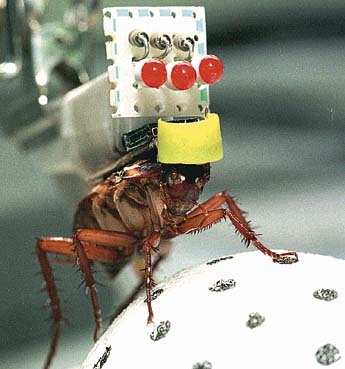
University of Tokyo
“Be on guard next time you step into the shower,” translates Ron Henderson from Sydsvenska Dagbladet:
It might not be a regular cockroach watching you on the ceiling. It could be a well-heeled voyeur’s spy filming you! 24
“Cybernetically enhanced bugs have become a reality,” notes William Eazel in an article for the wireheading.com website, “meaning that humanity may have more to worry about than the threat of AI-style robots taking over the world.” 25
Announced by the University of Tokyo in January 1997, Time Magazine reports:
Using hardy American roaches, scientists remove their wings, insert electrodes in their antennae and affix a tiny backpack of electric circuits and batteries to their carapace. The electrodes prod them to turn left and right, go backward and forward. The plan is to equip them with minicameras or other sensory devices.26

BBC News
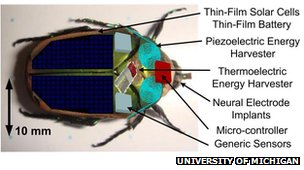
“The Pentagon’s defence scientists want to create an army of cyber-insects that can be remotely controlled to check out explosives and send transmissions,” alerts BBC News to U.S. Pentagon plans involving the development of Hybrid Insect Microelectromechanical Systems (HI-MEMS) cyber-insects. “The idea is to insert micro-systems at the pupa stage, when the insects can integrate them into their body, so they can be remotely controlled later”:
A similar scheme aimed at manipulating wasps failed when they flew off to feed and mate.
The new scheme is a brainwave of the Defence Advanced Research Projects Agency (Darpa), which is tasked with maintaining the technological superiority of the US military. It has asked for “innovative” bids on the insect project from interested parties.
Darpa believes scientists can take advantage of the evolution of insects, such as dragonflies and moths, in the pupa stage. “Through each metamorphic stage, the insect body goes through a renewal process that can heal wounds and reposition internal organs around foreign objects,” its proposal document reads. The foreign objects it suggests to be implanted are specific micro-systems – Mems – which, when the insect is fully developed, could allow it to be remotely controlled or sense certain chemicals, including those in explosives. The invasive surgery could “enable assembly-line like fabrication of hybrid insect-Mems interfaces”, Darpa says. A winning bidder would have to deliver “an insect within five metres of a specific target located 100 metres away”. The “insect-cyborg” must also “be able to transmit data from relevant sensors, yielding information about the local environment. These sensors can include gas sensors, microphones, video, etc.” 27
Frank Swain describes a number of examples of cybernetic organisms (cyborgs) in How to Make a Zombie:
Cornell University researchers have been able to take control of hawk moths in flight. On the other side of the US, scientists at the University of California, Berkeley, posted a video on YouTube that showed a fist-sized giant flower beetle take flight and veer about a room following the commands tapped into a laptop. Going one better, in 2007 Su Xuecheng and a team of fellow students at the Robot Engineering Technology Research Centre, at Shandong University of Science in China, created remote-controlled pigeons.28
“Rats can be made to run, jump or climb, following instructions they receive by radio from a laptop computer,” reports Mike Finch for the American Free Press. “Clacking keys on a computer send these ‘ratbots’ climbing trees, winding through mazes, or searching through building rubble”:
“Our discovery grew out of ongoing research into the development of thought-controlled prosthetic devices for spinal chord [sic] injury,” said John K. Chapin, Ph.D., research partner of Sanjiv Talwar, M.D., Ph.D.
The brain implants have already enabled rats to move robotic arms by thought alone.
With testing being done on primates, some worry that this technology could eventually be used to control humans.29
“Asked to speculate on potential military uses for robotic animals, Dr Talwar [of the State University of New York] agreed they could, in theory, be put to some unpleasant uses, such as assassination,” notes The Guardian.30
“It will mean that every non-human life form in the server room will have to be exterminated,” said one security expert quoted in the wireheading.com article.31
"Scientists at Harvard hooked a monkey’s brain up to a neural net and tried to stimulate individual neurons responsible for recognizing faces," writes Dan Robitski for Futurism. "By showing the monkey images generated by the AI, the scientists tried to activate those particular neurons as much as possible."
Eventually, the AI system learned to generate images that would trigger individual brain cells without also activating any of their neighbors, according to The Atlantic. These images often took the form of surreal nightmare pictures that vaguely resembled faces or other familiar shapes — a provocative example of how sensors and AI are starting to peer into the biological brain.32


University of California, Berkeley
Neural implants have even allowed us to see through an animal’s eyes by processing signals in the brain.33 As BBC News reported in 1999:
By recording the electrical activity of nerve cells in the thalamus, a region of the brain that receives signals from the eyes, researchers from the University of California at Berkeley were able to view these shapes.… They recorded the output from 177 brain cells that responded to light and dark in the cat’s field of view. In total, the 177 cells were sensitive to a field of view of 6.4 by 6.4 degrees.… Given time, it will be possible to record what one person sees and “play it back” to someone else either as it is happening or at a later date.34

neural network: DTREG/MLFN

A microscopic view of the “brain in a dish,” or
rat neurons growing on a multi-electrode array
in a petri dish. (Tom DeMarse)

Neurons have even been cultured on a computer chip that in a matter of minutes learned how to control a virtual F-16 fighter jet. “Enzymes were used to extract neurons from the motor cortex of mature rat embryos and cells were then seeded onto a grid of [60] gold electrodes patterned on a glass Petri dish,” reports the NewScientist.com website. University of Florida in Gainesville biomedical engineer Thomas “DeMarse’s array of 25,000 interconnected neurons were able to convert signals that indicated whether the simulated plane is experiencing stable conditions or hurricanes into a measurement of whether the plane is flying straight or tilted and then correct the flight path by transmitting signals to the airplane’s controls.” 35
“When the system is first engaged, the neurones don’t know how to control the aeroplane; they don’t have any experience,” notes the Australian Broadcasting Company:
“Over time, these stimulations modify the network’s response such that the neurones slowly [over the course of 15 minutes] learn to control the aircraft,” [DeMarse] said. “The end result is a neural network that can fly the plane to produce relatively stable straight and level flight.” 36

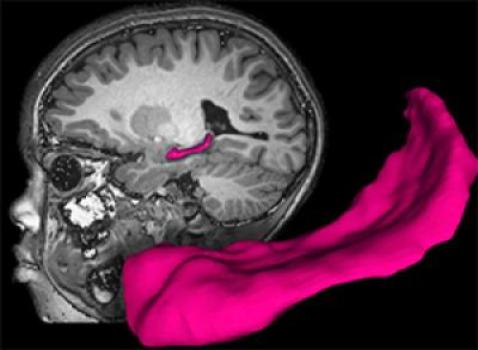
“(The brain is) getting its network to the point where it’s a live computation device,” said DeMarse in the University of Florida press release.37 ABC News reports on additional neural computer studies noting:
It is clear that a marriage between neurology, or the study of the human brain, and high speed computers is leading into territory that sounds more like science fiction than fact. Some experts have warned that incredibly smart machines might someday leave the rest of us in the dust, usurping our self-appointed role as the most important creatures on the planet, if not the universe.38
“We’re closer to becoming real cyborgs than most people realize,” writes the io9.com website. “With our brains connected to computers at a fundamental level.” 39 NewScientist.com reports:
The world’s first brain prosthesis – an artificial hippocampus – is about to be tested in California. Unlike devices like cochlear implants, which merely stimulate brain activity, this silicon chip implant will perform the same processes as the damaged part of the brain it is replacing.…The job of the hippocampus appears to be to “encode” experiences so they can be stored as long-term memories elsewhere in the brain.40

Futurama, FOX Entertainment
IBM, “along with four universities and the Defense Advanced Research Projects Agency (DARPA), have created the basic design of an experimental computer chip that emulates the way the brain processes information,” reports the VentureBeat.com website. “IBM’s so-called cognitive computing chips could one day simulate and emulate the brain’s ability to sense, perceive, interact and recognize – all tasks that humans can currently do much better than computers can.” 41

“Researchers [from Wake Forest University, the University of California, and the University of Kentucky] performed surgery on 11 rats,” writes Michael Joseph Gross in “The Pentagon’s Push to Program Soldiers’ Brains” for The Atlantic:
"In an article in the Journal of Neuroscience researchers found that levels of the inhibitory neurotransmitter gamma-Aminobutyric acid (GABA) in the visual cortex predicts time perception (Terhune et al., 2014)," writes Armin Krishnan in Military Neuroscience and the Coming Age of Neurowarfare. "Based on these findings, University of Oxford Philosopher Rebecca Roache has argued that the manipulation of time perception through this neurotransmitter could be a cost-effective method of punishment":Into each rat’s brain, an electronic array—featuring 16 stainless-steel wires—was implanted. After the rats recovered from surgery, they were separated into two groups, and they spent a period of weeks getting educated, though one group was educated more than the other. When the more educated group of rats attained mastery of this task, the researchers exported the neural-firing patterns recorded in the rats’ brains—the memory of how to perform the complex task—to a computer.
“What we did then was we took those signals and we gave it to an animal that was stupid,” Geoff Ling said at a DARPA event in 2015—meaning that researchers took the neural-firing patterns encoding the memory of how to perform the more complex task, recorded from the brains of the more educated rats, and transferred those patterns into the brains of the less educated rats—”and that stupid animal got it. They were able to execute that full thing.” Ling summarized: “For this rat, we reduced the learning period from eight weeks down to seconds.” 42
Instead of locking convicts up for years at taxpayer's expense, they could be given the drug and spend a few days or months in prison, which they could perceive as 1000 years of incarceration (Love, 2014). On her practical ethics blog Roache explores the idea of 'virtual prisons':
Similarly, uploading the mind of a convicted criminal [into a computer] and running it a million times faster than normal would enable the uploaded criminal to serve a 1,000 year sentence in eight-and-a-half hours. This would, obviously, be cheaper for the taxpayer than extending criminals' lifespans to enable them to serve 1,000 years in real time. Further, the eight-and-a-half hour 1,000 year sentence could be followed by a few hours (or, from the point of view of the criminal, several hundred years) of treatment and rehabilitation. Between sunrise and sunset, the vilest criminals could serve a millennium of hard labour and return fully rehabilitated either to the real world (if technology facilitates transferring them back to a biological substrate), or perhaps to exile in a simulated computer world. (Roache, 2014)43
"Implanting computing power in the brain could help humans have near-perfect memory, read books instantaneously and communicate with other implanted humans telepathically," explains Kernel founder Bryan Johnson, who designs computer chips "which are actually neurotechnological hardware designed to read and write neural code."44
“First we get our chatbots to sound and act realistic – and then we get them to convince everyone they’re actually human,” writes George Dvorsky on IO9 about Time’s run-in with such a software application.45 Wikipedia writes:
A chatter robot, chatterbot, chatbot, or chat bot is a computer program designed to simulate an intelligent conversation with one or more human users via auditory or textual methods, primarily for engaging in small talk. The primary aim of such simulation has been to fool the user into thinking that the program’s output has been produced by a human (the Turing test).
Programs playing this role are sometimes referred to as Artificial Conversational Entities, talk bots or chatterboxes. In addition, however, chatterbots are often integrated into dialog systems for various practical purposes such as offline help, personalised service, or information acquisition. Some chatterbots use sophisticated natural language processing systems, but many simply scan for keywords within the input and pull a reply with the most matching keywords, or the most similar wording pattern, from a textual database.
The term “ChatterBot” was originally coined by Michael Mauldin (Creator of the first Verbot, Julia) in 1994 to describe these conversational programs [Mauldin, Michael (1994), “ChatterBots, TinyMuds, and the Turing Test: Entering the Loebner Prize Competition”, Proceedings of the Eleventh National Conference on Artificial Intelligence, AAAI Press, retrieved 2008-03-05, abstract].46
The ChatGPT artificial intelligence chatterbot insists the Bible's Matthew 20 shouldn't be taken literally, effectively telling everyone that Jesus didn't say get your lazy butts to work building heaven:
The Parable of the Workers in the Vineyard, Matthew 20 “For the kingdom of heaven is like a landowner who went out early in the morning to hire workers for his vineyard. 2 He agreed to pay them a denarius for the day and sent them into his vineyard. 3 “About nine in the morning he went out and saw others standing in the marketplace doing nothing. 4 He told them, ‘You also go and work in my vineyard, and I will pay you whatever is right.’ 5 So they went. “He went out again about noon and about three in the afternoon and did the same thing. 6 About five in the afternoon he went out and found still others standing around. He asked them, ‘Why have you been standing here all day long doing nothing?’ 7 “‘Because no one has hired us,’ they answered. “He said to them, ‘You also go and work in my vineyard.’ 8 “When evening came, the owner of the vineyard said to his foreman, ‘Call the workers and pay them their wages, beginning with the last ones hired and going on to the first.’ 9 “The workers who were hired about five in the afternoon came and each received a denarius. 10 So when those came who were hired first, they expected to receive more. But each one of them also received a denarius. 11 When they received it, they began to grumble against the landowner. 12 ‘These who were hired last worked only one hour,’ they said, ‘and you have made them equal to us who have borne the burden of the work and the heat of the day.’ 13 “But he answered one of them, ‘I am not being unfair to you, friend. Didn’t you agree to work for a denarius? 14 Take your pay and go. I want to give the one who was hired last the same as I gave you. 15 Don’t I have the right to do what I want with my own money? Or are you envious because I am generous?’ 16 “So the last will be first, and the first will be last.” — NIV

“Some people think of cybernetics as the artificial construction of human beings, whether by artificial seeds that grow into an embryo and then a human being, or directly,” writes F.H. George in Cybernetics.47
The game Warhammer introduces players to the concept of gene-seeds which are
germ cells and viral machines that have been genetically-engineered to develop into the various organs that are implanted into a normal human adolescent male to transform him into a Space Marine.… The gene-seed itself is encoded with all the genetic information needed to reshape ordinary human cell clusters into the special organs.48
Like today’s technology seeding a decellularized organ scaffold to become an ear or a heart “without the risk of rejection by the recipient’s immune system,” writes Brendan Maher for Nature,49 humans of tomorrow may regularly upgrade their original parts for genetically enhanced models.
But “not everyone is thrilled at the prospect of a post-human future populated by cyborgs, designer children, conscious computers, immortals and disembodied minds roaming the Internet,” worries Margie Wylie for the Religion News Service:
[Critics] think this could be the worst calamity to befall us, both as individuals and as a species. And they argue we should be taking steps to prevent it. 50
Kevin Warwick, Professor of Cybernetics at the University of Reading, sees a future of possibilities. “Whilst some of his research has focused on restoring functions that people taken away by illness and disability, other projects give powers humans have never had,” it says of his cyborg experiments.51
Marvin Minsky, a Massachusetts Institute of Technology professor and pioneer in the field of artificial intelligence, “celebrates a future when humans will be able to ‘upload’ the contents of their brains into computers or robot brains”, continues Wylie.
Ray Kurzweil “recently called for replacing the body’s often imperfect molecular blueprint, DNA, with software”:
“Transhumanists want to use technology to enhance and fulfill human potential,” [James Hughes, executive director of the World Transhumanist Association based in Willington, Conn.,] said. “That’s very hard to do if you die after only 70 years.” 52
“Humanity’s ability to alter its own brain function might well shape history as powerfully as the development of metallurgy in the Iron Age,” cognitive neuroscientist Martha Farah and eight co-authors write in a[n]…issue of Nature Reviews Neuroscience.53
Professor Kevin Warwick contemplates the future of humanity in his book I, Cyborg:
If cyborgs are created with superhuman capabilities from a normal human start point, then it certainly brings about a threat to humanity itself. Perhaps the development of direct, military-style cyborgs might be possible to avoid. After all, when cyborgs exhibiting an intelligence that far surpasses that of humans are brought about, it will surely be the cyborgs themselves that make any decisions about how they treat humans.54, ii
“Coupled with exponentially advancing technologies, an enhanced knowledge of brain function will allow us to develop brain implants that have the speed, power, and memory to replicate the functionality of the entire human brain,” notes Stephen S. Wu and Marc Goodman for the American Bar Association:
Moreover, there is no reason why the brain must be limited to onboard devices. If we can connect devices to off-board devices, we will have potentially unlimited processing power and memory. In addition, the next logical step is to connect our neural devices to the Internet so that we can share, add to, and manipulate the entire world’s information.
One well-known futurist, Ray Kurzweil, has predicted that around midcentury, computers and artificial intelligence will be so powerful, humans will be able to transfer their lifetime’s worth of memories to computers and carry on their thought processes and remember information using computers so that their thinking can be independent from their organic brains.55
Writes Anthony Cuthbertson for The Independent, "A completely paralyzed man, who was left unable to communicate for months after losing the ability to even move his eyes, has used a brain implant to ask his caregivers for a beer. Composing sentences at a rate of just one character per minute, the man also asked to listen to the band Tool 'loud', requested a head massage from his mother, and ordered a curry – all through the power of thought." 56
"Nonetheless, there will always be those who oppose transhuman aspirations with the put down that they are unnatural," notes Frank Swain for BBC Future:
Neil Harbisson, who wears an antenna that allows him to hear colour, debunks the idea that it is anything unnatural. “Some might think that we might become less human if we modify ourselves but I believe there is nothing more human than doing that,” he says. “I strongly disagree with those who think that our union with technology will alienate ourselves from reality, from nature or from other livings. In my case, becoming technology doesn’t make me feel closer to machines, or to robots, but quite the opposite. Having an antenna makes me feel closer to insects and other creatures that have antennae, hearing through bone conduction make me feel closer to dolphins and other marine species that perceive sound through their bones, having ultraviolet and infrared perception makes me feel closer to insects and mammals that perceive these colours. I feel a stronger connection with nature now than I ever did before. Technology can bring us back to nature.” 57
"Should cyborgization be limited to only medical and therapeutic uses such as prosthetics?" asks Acharya Samudra for AtomsTalk.com:
Is becoming a cyborg just to enhance the limits of an otherwise healthy body valid? Then again, there are cases like Neil Harbisson which fall right in between both the categories.
If we allow humans to become cyborgs in order to increase their bodily functions or gain new abilities, how much is all right, and how much is too much? Who should decide what is right, anyway?58

Footnotes
i The HowThingsWork.com website notes how today’s computers “work by manipulating bits that exist in one of two states: a 0 or a 1″ but that quantum computers aren’t limited to two states; they encode information as quantum bits, or qubits, which can exist in superposition.”
— Kevin Bonsor and Jonathan Strickland, “How Quantum Computers Work,” HowThingsWork.com, at http://
ii Decision making, like memory, is a multifaceted process that involves many neural circuits, depending on the decision being made.
— Benedict Carey, “Brain Implant Improves Thinking in Monkeys, First Such Demonstration in Primates,” The New York Times, 14 September 2012, at http://www.nytimes.com/2012/09/14/health/research/brain-implant-improves-thinking-in-monkeys.html (retrieved: 31 December 2012).
References
1 “Claude Shannon,” New York University, at http://www.nyu.edu/
2 Graham P. Collins, “Claude E. Shannon: Founder of Information Theory,” Scientific American, 14 October 2002, at http://www.scientificamerican.com/
3 “Claude Shannon,” New York University.
4 Robert I. Watson, Sr., and Rand B. Evans, The Great Psychologists: A History of Psychological Thought, 5th ed. (New York: HarperCollins Publ., Inc., 1991), p. 623.
5 Arthur Porter, Cybernetics Simplified (New York, NY: Barnes & Noble, Inc., 1969), p. v.
6 Norbert Wiener, Cybernetics: Or Control and Communication in the Animal and the Machine (New York, NY: The Technology Press, 1949, 1948), p. 19.
7 F.H. George, Cybernetics (London: Teach Yourself Books, 1971), p. 3.
8 Ibid., p. 4.
9 Ibid., p. 128.
10 Wiener, p. 36.
11 Ibid., pp. 38-39.
12 George, p. 189.
13 “Changing People’s Minds, Tulane Style: A Tale From Two Perspectives,” Tulanelink.com, at http://www.tulanelink.com/
14 Frank Swain, How to Make a Zombie: The Real Life (and Death) Science of Reanimation and Mind Control (London: Oneworld, 2013), p. 133.
15 Vance Packard, The People Shapers (Boston: Little, Brown & Co., 1977), p. 45.
16 vaughanbell, “Erotic self-stimulation and brain implants,” MindHacks.com, 16 September 2008, at http://mindhacks.com/2008/09/16/erotic-self-stimulation-and-brain-implants/ (retrieved: 26 March 2015).
17 John A. Osmundsen, “‘Matador’ With a Radio Stops Wired Bull,” The New York Times, 17 May 1965, CXIV(39,195), pp. 1, 20.
18 Electro-Magnetic Mind Control Weapons, transcript, CNN: Special Assignment, WorldAviation.info, at http://iron-eagles.tripod.com/articles/emmc.htm (retrieved: 7 December 2013).
19 José M.R. Delgado, M.D., Physical Control of the Mind: Toward a Psychocivilized Society (New York, NY: Harper & Row, Publishers, 1969), pp. 115-116; See also https://www.google.com/
20 Keith Veronese, “The Scientist Who Controlled People with Brain Implants,” i09, 28 December 2011, at http://io9.com/5871598/the-scientist-who-controlled-peoples-minds-with-fm-radio-frequencies/+keithveronese (retrieved: 20 September 2014).
21 Norman D. Livergood, “Brain, Mind, and Altered States of Consciousness,” at http://www.hermes-press.com/altstates.htm (retrieved: 25 March 2011); See also: Professor Kevin Warwick, I, Cyborg (London: Century, 2002), p. 110.
22 Jim Keith, Mind Control, World Control (Kempton, IL: Adventures Unlimited Press, 1998), p. 130.
23 Hal Hodson, "20 billion nanoparticles talk to the brain using electricity," New Scientist, 8 June 2015, at https://www.newscientist.com/article/dn27676-20-billion-nanoparticles-talk-to-the-brain-using-electricity/ (retrieved: 2/2/2023).
24 Ron Henderson, trans., “Cockroaches on a secret mission,” Sydsvenska Dagbladet, 18 January 1997, at http://magazine.magnus.se/artikele.asp?artikel=kackerla (retrieved: 12 December 2013).
25 William Eazel, “Robo-roach brings Judgement Day closer,” (source VNUNET, September 2001), Wirehead Hedonism, at http://www.wireheading.com/roboroach/robo-roaches.html (retrieved: 1 May 2011).
26 “Peepers creepers; Research at the University of Tokyo is investigating ways in which cockroaches with the mini-mini-cameras can be used to locate vermin or perhaps even survivors of earthquakes,” Time, 27 January 1997, 149(4), p. 17.
27 Gary Kitchener, “Pentagon plans cyber-insect army,” BBC News, 16 March 2006, at http://news.bbc.co.uk/2/hi/americas/4808342.stm (retrieved: 25 March 2011).
28 Swain, Zombie, p. 140.
29 Mike Finch, “Remote Control Rodent ‘Ratbots’ Pass First Tests,” American Free Press, at http://www.americanfreepress.net/
30 James Meek, “Live rats driven by remote control,” The Guardian, 2 May 2002, at http://www.guardian.co.uk/world/2002/may/02/
31 Eazel, “Robo-roach.”
32 Dan Robitski, Futurism, 22 May 2019, at https://futurism.com/neural-net-monkey-brain-bizarre-images (retrieved 19 April 2022).
33 Robert Sanders (Public Affairs), “Reconstructed movie showing animal view of world proves scientists have a good understanding of how the brain processes visual information,” University of California, Berkeley, 15 October 1999, at http://www.berkeley.edu/
34 Dr. David Whitehouse, “Looking through cats’ eyes,” BBC News, 11 Oct 1999, at http://news.bbc.co.uk/2/hi/science/nature/471786.stm (retrieved: 1 May 2011); See also: Garrett B. Stanley, Fei F. Li, and Yang Dan, “Reconstruction of Natural Scenes from Ensemble Responses in the Lateral Geniculate Nucleus,” The Journal of Neuroscience, 15 Sep 1999, 19(18):8036-8042, at http://www.jneurosci.org/
35 Celeste Biever (Discovery News), “Brain cells in a dish fly fighter plane,” NewScientist.com, 26 Oct 2004, at http://www.newscientist.com/
36 Jennifer Viegas (Discovery News), “Brain-in-a-dish flies plane,” Australian Broadcasting Company, 26 Oct 2004, at http://www.abc.net.au/
37 “UF scientist: ‘Brain’ in a dish acts as autopilot, living computer,” University of Florida press release, 21 Oct 2004, at http://www.eurekalert.org/
38 Lee Dye, “Scientist Build a ‘Brain’ From Rat Cells,” ABC News, 30 Oct 2004, at http://abcnews.go.com/
39 “We’re closer to becoming real cyborgs than most people realize,” io9, 19 September 2011, at http://io9.com/
40 Duncan Graham-Rowe, “World’s first brain prosthesis revealed,” NewScientist.com, 12 March 2003, at http://www.newscientist.com/
41 Dean Takahashi, “IBM produces first working chips modeled on the human brain,” VentureBeat.com, 17 August 2011, at http://venturebeat.com/
42 Michael Joseph Gross, “The Pentagon’s Push to Program Soldiers’ Brains,” The Atlantic, November 2018, at https://www.theatlantic.com/magazine/archive/2018/11/the-pentagon-wants-to-weaponize-the-brain-what-could-go-wrong/570841/ (retrieved: 15 October 2018).
43 Armin Krishnan, Military Neuroscience and the Coming Age of Neurowarfare (New York, NY: Routledge, 2017), pp. 201-202; See also Love, D. (2014) 'Future Mind-Altering Drugs Could Make Prisoners Think They're in Jail for 1000 Years', Business Insider, 19 August, [Online], Available: www.businessinsider.com/drugs-alter-prisoners-perception-of-time-2014-8 [Accessed 29 December 2015]; Terhune, D.B., Russo, S., Near, J., Stagg, C.J. and Kadosh, R.C. (2014) 'GABA predicts Time Perception', Journal of Neuroscience, vol 34, no. 12, pp.4364-4370; Roache, R. (2014) 'Enhanced Punishments: Can Technology Make Life Sentences Longer?', [Online], Available: blog.practicalethics.ox.ac.uk/2013/08/enhanced-punishment-can-technology-make-life-sentences-longer/ [Accessed 29 December 2015].
44 "Ahead of Elon Musk, this self-made millionaire already launched a company to merge your brain with computers," CNBC, 12 April 2017, at https://www.cnbc.com/2017/04/12/self-made-millionaire-leads-elon-musk-in-fusing-brains-and-computers.html (retrieved: 2 January 2023).
45 George Dvorsky, “Freakishly realistic telemarketing robots are denying they’re robots,” 12 December 2013, at http://io9.com/freakishly-realistic-telemarketing-robots-are-denying-t-1481050295 (retrieved: 12 December 2013); See also Zeke Miller and Denver Nicks, “Meet the Robot Telemarketer Who Denies She’s A Robot,” 10 December 2013, at Meet the Robot Telemarketer Who Denies She’s A Robot (retrieved: 12 December 2013).
46 Chatterbot, Wikipedia.org, at http://en.wikipedia.org/
47 F.H. George, Cybernetics (London: Teach Yourself Books, 1971), p. 6.
48 “Gene-Seed,” Warhammer 40,000 Wiki, at http://warhammer40k.wikia.com/
49 Brenden Maher, “Tissue engineering: How to build a heart,” Nature, 3 July 2013, at http://www.nature.com/
50 Margie Wylie (Religion News Service), “Transhumanists put their faith in technology,” Chicago Tribune, 28 May 2004, at http://www.chicagotribune.com/
51 Kevin Warwick – The Cyborg Experiments, The University of Warwick, at http://www2.warwick.ac.uk/
52 Wylie, “Transhumanists.”
53 Tom Siegfried, “Creating brain boosters demands smart approach,” DallasNews.com, 6 June 2004, at http://www.dallasnews.com/
54 Warwick, http://www.hermes-press.com/altstates.htm (retrieved: 25 March 2011); See also: Professor Kevin Warwick, I, Cyborg (London: Century, 2002), p. 239.
55 Stephen S. Wu and Marc Goodman, “SCIENCE AND TECHNOLOGY LAW: Neural Implants and Their Legal Implications,” American Bar Association, Vol. 30, No. 1, at http://www.americanbar.org/
56 Anthony Cuthbertson, "‘I want a beer’: Paralysed man communicates first words in months using brain implant," 24 March 2022, at https://finance.yahoo.com/news/want-beer-paralysed-man-communicates-154452109.html (referenced: 19 April 2022).
57 Frank Swain, "Cyborgs: The truth about human augmentation," BBC Future, 23 September 2014, at https://www.bbc.com/future/article/20140924-the-greatest-myths-about-cyborgs (retrieved: 3 January 2023).
58 Acharya Samudra, "Cyborgs: Everything You Need To Know," AtomsTalk.com, at https://atomstalk.com/blogs/cyborgs/ (retrieved: 3 January 2023).
culture jam
skewsme.com/cyborgs-flier.pdf
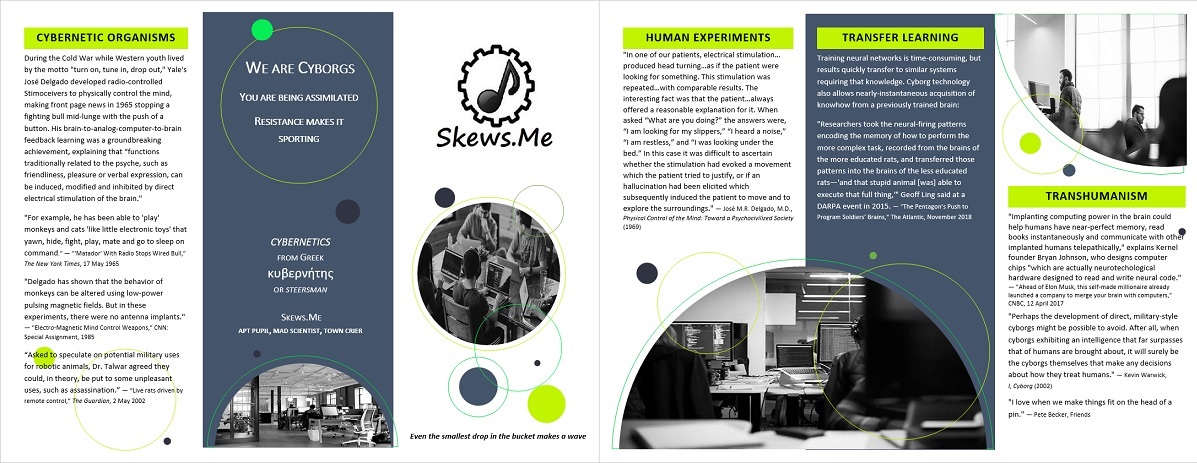



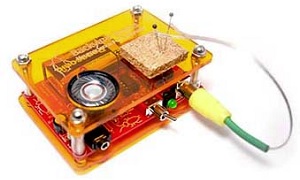







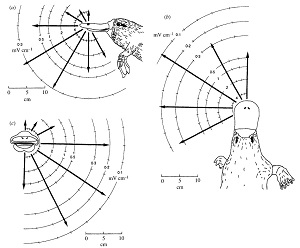

 The philosophy of Epicurus who subscribed to a hedonistic ethics that considered an imperturbable emotional calm the highest good, held intellectual pleasures superior to others, and advocated the renunciation of momentary in favor of more permanent pleasures.
The philosophy of Epicurus who subscribed to a hedonistic ethics that considered an imperturbable emotional calm the highest good, held intellectual pleasures superior to others, and advocated the renunciation of momentary in favor of more permanent pleasures.


